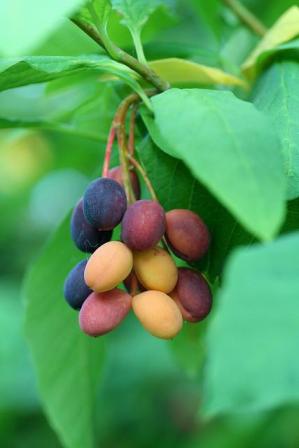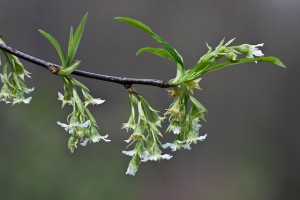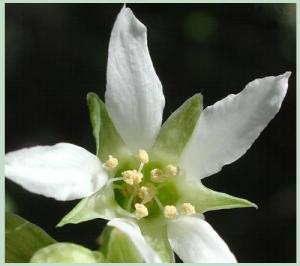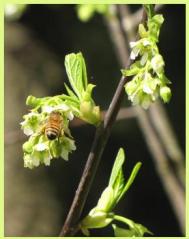The Spring Mouse is
running, jumping
in love with the world
– Ellen O’Shea (Spring of 1978)
 It is early spring. How do I know? The days are getting longer, the temperatures are rising just a bit. The daffodils are blooming. The red-wing black bird and hummers have returned. And, the Indian-plum is blooming in the forest.
It is early spring. How do I know? The days are getting longer, the temperatures are rising just a bit. The daffodils are blooming. The red-wing black bird and hummers have returned. And, the Indian-plum is blooming in the forest.
For the past few months I have been writing about some of the native deciduous trees of the Cascadian bio-region. Indian plum is listed as being a shrub or small tree by some native plant botanists (Pojar and MacKinnon). So I will be diverging somewhat on my original goal to teach you about what I think are the ten most important deciduous trees for now.
It is said that those who live close to nature let her lead us through the seasons, through time and through dimensions of reality. Indian plum opens the door to spring like no other plant in the Cascadian forest.
Indian-Plum or Osoberry is a plant that I spend several months watching closely because it  announces the coming of spring and the coming of the pollinators. Its lovely buds are the first to appear in the forest. The flower comes early allowing the bees to survive the long winter. And I am given hope that the hours of sunlight will become longer. It is a barometer that shows how close we are to spring and thr renewal of the forest and all the lands. It often appears with Red flowering Currant (Ribes sanguineum) another pollinator favorite.
announces the coming of spring and the coming of the pollinators. Its lovely buds are the first to appear in the forest. The flower comes early allowing the bees to survive the long winter. And I am given hope that the hours of sunlight will become longer. It is a barometer that shows how close we are to spring and thr renewal of the forest and all the lands. It often appears with Red flowering Currant (Ribes sanguineum) another pollinator favorite.
NAME
Chehalis – t’ saxwani, whole plant, the berry was called t’saxwa
Lummi – molxwu’n
Quinalt – tekadja’nt, “coffee berries”
Samish – t’sxuni’ltc
Skagit – siqwad
According to Erna Gunther a Ethnobotantist from the 1940’s and 50’s, the plant was named Osoberry by early Spanish explorers to the Cascadian bio-region. A Spanish name for Bear was Oso. Spanish soldiers and Spanish catholic priests who came to Cascadia years ago saw bears eating the fruit and so they named the plant Osoberry (Gunther p.37).
Oregon plum, Indian peach, and bird cherry are also synonyms.
Also known as Osmaronia cerasiformis
PLANT
Indian-plum is a fast growing but relatively short-lived perennial deciduous shrub or small tree of 6 to 16 feet. An attractive deciduous shrub to small tree , a green woodsy plant that resembles a pussywillow until it flowers or fruits. It said if you rub the leaves together there is faint smell of watermelon.
FLOWERS
 Greenish white flowers approximately 1 cm across. 5 petals, 15 stamens in distinct series somewhat bell-shaped, appear often before the leaves in very early spring. The flowers hang in 5 to 10 cm long clusters. Flowers are like many natives, usually males on one plant and females on others, except on good years (or maybe bad years?) then you will find both on the same plant. The female plant produces flowers that smell like watermelon, and this plant produces the fruit. The male flower is said to smell something like cat urine. Indian-plum flowers at the same time as the genus Ribes which includes the edible currants (blackcurrant, redcurrant, whitecurrant, gooseberry, and several hybrid varieties). These plants attract the same pollinators.
Greenish white flowers approximately 1 cm across. 5 petals, 15 stamens in distinct series somewhat bell-shaped, appear often before the leaves in very early spring. The flowers hang in 5 to 10 cm long clusters. Flowers are like many natives, usually males on one plant and females on others, except on good years (or maybe bad years?) then you will find both on the same plant. The female plant produces flowers that smell like watermelon, and this plant produces the fruit. The male flower is said to smell something like cat urine. Indian-plum flowers at the same time as the genus Ribes which includes the edible currants (blackcurrant, redcurrant, whitecurrant, gooseberry, and several hybrid varieties). These plants attract the same pollinators.
HABITAT
Often found with an overstory of Douglas-Fir, Western Redcedar or Cottonwood. Found in dry to moist, open woods, streambanks, roadsides: found in lower elevations. If growing in a more sunny location it will develop more dense foliage and have more flowers and fruit.
Indian plum is native and common at lower elevations from extreme southwest British Columbia to Oregon’s Willamette Valley and surrounding foothills. Continuing south, it becomes less common in the California Coast Ranges to Santa Barbara County and western slopes of the Sierra Nevada Mountains to Tulare County California.
This plant spreads slowly, mostly by root suckering. Although Indian plum seed is dispersed by many birds and mammals, it requires a disturbed site in order to become established.
PROPAGATION TECHNIQUES
Seeds can be collected and sown outdoors in the fall or spring. Germination of spring-sown seed is more successful if the seeds are first given cold treatment or stratified. Place seeds in a bag of moist peat moss and store them in the freezer for four months. Half-ripe cuttings, taken in the summer are often successful. Suckers can also be removed from the parent plant during the winter months, and will survive on their own provided great care is taken.
MEDICINE, FOOD AND UTILITY
The berry or plum was eaten by the First Peoples in small amounts. They were sometimes dried and combined with other wild berries to make a dried fruit leather. The fresh fruit was gathered as people walked through the forest and was only dried to use as a starvation food (Gunther p.37). The dried berries were eaten in the winter time. The Saanich made a bark tea as a purgative and tonic (Pojar and Mackinnon p. 72)
Indian Plum has a analgesic quality to it and the Kwakiutl created a poultice by chewing, and burning the plant and oil and then applying to sore places (Moerman p. 360). A tea of the bark was used as a laxative. The bark was stripped to make harpoon hooks and other utility items.
Many Cascadian tribes ate the berries fresh with oil at an evening meal. They were often mixed with wild currants.
Indian plums have been used to make wine. They lack sweetness and are sometimes mixed with Red Currant and other sweeter fruit in the winemaking process.
WILDLIFE
This plant is very important to pollinator and animal survival. The shrub is one of the first to flower in the spring and is therefore an essential food for bees and other early  spring pollinators. It is said that the wild and honey bees come for the Indian -plum and stay on for all the other plants starting to bloom. When this plant is missing from the forest, many bees do not show up in time to pollinate later flowering plants. Interesting that this plant is the first to bloom and one of the last to set fruit in the summer. It is to be noted that Indian-plum cannot self-pollinate. If the bees and other pollinators disappear from our eco-systems, so too will the Indian-plum disappear.
spring pollinators. It is said that the wild and honey bees come for the Indian -plum and stay on for all the other plants starting to bloom. When this plant is missing from the forest, many bees do not show up in time to pollinate later flowering plants. Interesting that this plant is the first to bloom and one of the last to set fruit in the summer. It is to be noted that Indian-plum cannot self-pollinate. If the bees and other pollinators disappear from our eco-systems, so too will the Indian-plum disappear.
The berries are essential food for squirrels, birds and other forest dwellers. Various small mammals plus foxes, coyotes, deer, bears, and many bird species consume the ‘plums’ and disperse the seed. (USDA NRCS plant fact sheet)
Early hummingbirds are attracted to the tubular flowers of the Indian Plum.
A SPRING GIFT TO YOU!
A video of the spring SONG OF THE RED-WINGED BLACKBIRD. If you listen carefully you will hear geese, and other birds singing beautifully because it is spring!
REFERENCES
- Gunther, Erna. (1945) (Revised 1973) Ethnobotany of Western Washington. Knowledge and use of Indigenous plants by Native Americans, University of Washington Press.
- Meyer, Joseph E. (1918) (Revised 1970) The Herbalist, Meyer Books Publishing
- Moerman, Daniel E.(1998) Native American Ethnobotany, Timber Press, Portland and London
- Pojar & McKinnon, (1994) Plants of the Pacific Northwest Coast, Washington, Oregon, British Columbia & Alaska, Lone Pine Publishing, Vancouver, British Columbia
- Stuhr, Ernst T. (1933) Manual of Pacific Coast Drug plants, Ernst Theodore Stuhr Papers, Oregon State University Archives, Corvallis, Oregon.
- USDA NRCS Plant fact sheet: INDIAN PLUM Oemleria cerasiformis (Torr. & A. Gray ex Hook. & Arn.) Landon Plant Symbol = OECE Contributed by: USDA NRCS Corvallis, Oregon Plant Materials Center viewed online on March 17, 2013 -http://www.plant-materials.nrcs.usda.gov/pubs/orpmcfs9127.pdf